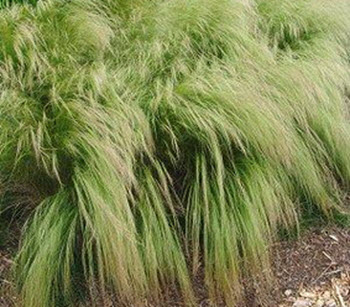Nassella lepida is also known under its commons names, “foothill needle grass” small-flowered stipe” or “small flower tussockgrass”. This perennial grass is a California native and grows prolifically all over the state. A well liked grass for feeding cattle, prized for the fast rate at which it grows back. The Nassella lepida can become truly old and have a lifespan of 100+ years, but once they disappear from a habitat they might not come back for just as long.
Morphology
 The grass stands up to 1 meter tall. Its leaves are either rolled up against the main stem or flat poking away from the stem, and grow up to 23 centimeters long. The grass’ flowers all sit on a long panicle, which measures up to 55 centimeters. The panicle is full of branches and on all of these sits small spikelets, up to 6 on each branch. Each of these spikelets has an awn that measures 4,5 to 5,4 centimeters. The flower is colored yellow. And unlike most grasses the Nassella lepida is deciduous and sheads its leaves in the winter.
The grass stands up to 1 meter tall. Its leaves are either rolled up against the main stem or flat poking away from the stem, and grow up to 23 centimeters long. The grass’ flowers all sit on a long panicle, which measures up to 55 centimeters. The panicle is full of branches and on all of these sits small spikelets, up to 6 on each branch. Each of these spikelets has an awn that measures 4,5 to 5,4 centimeters. The flower is colored yellow. And unlike most grasses the Nassella lepida is deciduous and sheads its leaves in the winter.
Habitat
This pretty grass appears throughout California in many different plant communities. It will rarely be spotted creating big stands together, but will mostly occur standing as lone individuals. If you go look for lepida in coastal prairie and valley grasslands, you will find them standing amongst different types of wild flowers such as Golden Yarrow, Sagebush and Buckwheat. If you find lepida in more desert-like environments, you will find them with other grasses of the same family.
Native Gardening
If you are trying to cultivate a native flora in your garden in California the Stipa lepida is on the “must know list”. Given that the plant if such an ordinary part of the flora local to California, the lepida help stabilizing some of the plants and keeping them in check, so they do not overgrow their boundaries. When planting a wildflower meadow you should plant a lepida every 3 feet, and a perennial every lepida to secure all balances are kept. The trick is that Lepida is highly competitive and by planting them among your regular flowers, they will help keep other weeds from sprouting. They will not remove it all, since a flower field is always under threat of intrusion from alien seeds, but given the viciousness of the plant and its habits of growing singularly, it makes as a good control plant.

